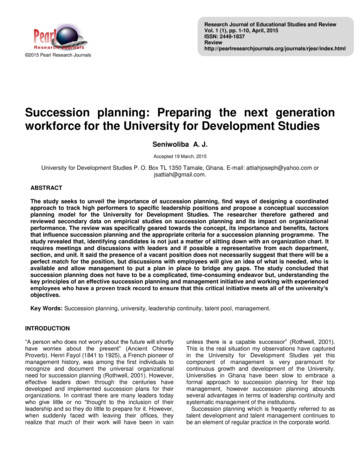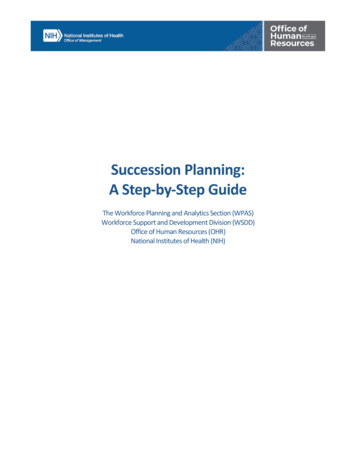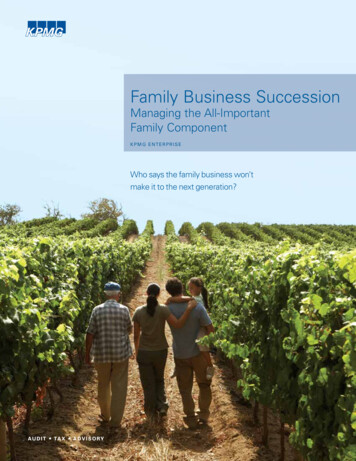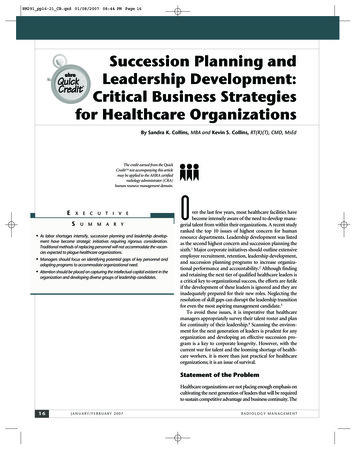
Transcription
Research Journal of Educational Studies and ReviewVol. 1 (1), pp. 1-10, April, 2015ISSN: urnals/rjesr/index.html 2015 Pearl Research JournalsSuccession planning: Preparing the next generationworkforce for the University for Development StudiesSeniwoliba A. J.Accepted 19 March, 2015University for Development Studies P. O. Box TL 1350 Tamale, Ghana. E-mail: attiahjoseph@yahoo.com orjsattiah@gmail.com.ABSTRACTThe study seeks to unveil the importance of succession planning, find ways of designing a coordinatedapproach to track high performers to specific leadership positions and propose a conceptual successionplanning model for the University for Development Studies. The researcher therefore gathered andreviewed secondary data on empirical studies on succession planning and its impact on organizationalperformance. The review was specifically geared towards the concept, its importance and benefits, factorsthat influence succession planning and the appropriate criteria for a succession planning programme. Thestudy revealed that, identifying candidates is not just a matter of sitting down with an organization chart. Itrequires meetings and discussions with leaders and if possible a representative from each department,section, and unit. It said the presence of a vacant position does not necessarily suggest that there will be aperfect match for the position, but discussions with employees will give an idea of what is needed, who isavailable and allow management to put a plan in place to bridge any gaps. The study concluded thatsuccession planning does not have to be a complicated, time-consuming endeavor but, understanding thekey principles of an effective succession planning and management initiative and working with experiencedemployees who have a proven track record to ensure that this critical initiative meets all of the university’sobjectives.Key Words: Succession planning, university, leadership continuity, talent pool, management.INTRODUCTION“A person who does not worry about the future will shortlyhave worries about the present” (Ancient ChineseProverb). Henri Fayol (1841 to 1925), a French pioneer ofmanagement history, was among the first individuals torecognize and document the universal organizationalneed for succession planning (Rothwell, 2001). However,effective leaders down through the centuries havedeveloped and implemented succession plans for theirorganizations. In contrast there are many leaders todaywho give little or no “thought to the inclusion of theirleadership and so they do little to prepare for it. However,when suddenly faced with leaving their offices, theyrealize that much of their work will have been in vainunless there is a capable successor” (Rothwell, 2001).This is the real situation my observations have capturedin the University for Development Studies yet thiscomponent of management is very paramount forcontinuous growth and development of the University.Universities in Ghana have been slow to embrace aformal approach to succession planning for their topmanagement, however succession planning aboundsseveral advantages in terms of leadership continuity andsystematic management of the institutions.Succession planning which is frequently referred to astalent development and talent management continues tobe an element of regular practice in the corporate world.
SeniwolibaMuch of the public sector especially higher education,however, has historically done little to systematicallyprepare key organizational leaders for advancement. Onthe contrary, where the leadership of an Institution plansstrategically, there is clear recognition that they arestrategically managing the human capital to drivetransformation and to support the accomplishment of theInstitution’s goals, that is to say, succession planning is anecessary part of the process.Conducting anappropriate gap analysis and developing professionalcompetencies is understood as key to futureorganizational success.Succession planning is the deliberate and systematiceffort made by leadership of organizations to recruit,develop and retain individuals with a range of leadershipcompetencies capable of implementing current and futureorganizational goals (Leibman et al., 1996). In the past ithas been seen largely as job replacement. Successionplanning now needs to include activities to attract,extend, and keep the best staff at all levels. It needs torecognize that younger leaders are likely to changeemployers and careers several times during their workinglife.Succession planning is best described as a consistentset of specific procedures to ensure the identification,development, and long-term retention of talentedindividuals. While this general definition works well,organizations view succession planning in many differentways (Schoonover, 2011). For some organizations, itsimply means making sure there are replacementcandidates for key positions, for others with a resents a deliberate and systematic effort to ensureleadership continuity in key positions, retain and developintellectual and knowledge capital within key employeesfor the future, encourage individual advancement, ensurethe stability or “bench strength” of key personnel, providean overarching approach to continue effectiveperformance of the organization, and organize concertedprogrammes for the development, replacement, andleveraging of key people to ensure a deep talent pipeline(Schoonover, 2011).In a similar vein, Rothwell (2001) opined thatsuccession planning and management is important forseveral reasons: the continued survival of theorganization depends on having the right people in theright places at the right times. Asaresultofrecenteconomic restructuring efforts in organizations,there are simply fewer people available to advance to thetop ranks from within. Succession planning andmanagement is needed to encourage diversity andmulticulturalism and avoid “homo-social reproduction” bymanagers and succession forms the basis forcommunicating career paths, establishing developmentand training plans, establishes career paths andindividual job moves.2According to the Texas State Auditor’s Office (SAO),“the purpose of succession planning is to prepare anagency for risks associated with the planned orunplanned loss of knowledge that is critical to thesuccess of the agency.” To accomplish this, a successfulsuccession planning model develops “employees toensure that the agency has highly qualified employeeswho are capable of filling critical positions” (SAO, 2006).Succession planning is a key element to both workforceplanning and strategic planning in state agencies.In today’s dynamic world where competition is high,work is fluid, environment is unpredictable, organizationsare flatter, and the organizational configurationrepeatedly changes, the old view of succession planningby defining specific individuals for specific tasks does notwork. Modern organizations perceive the necessity forcreating a pool of high-potential future candidates, on allorganization levels, to fill any needs, at any time. In thepast, organizations were busy searching for a substitutefor top executives and CEOs when their current topleaders were due to move out. At present, organizationsare more aware of the importance of the successionplanning possesses new perspective in that selecting, atall levels of the organization, preparing, developing, andretaining high-potential future leaders is their bridge tomaintaining sustainable competitive advantage in today’shighly revolutionary environment. Developing andretaining future leaders is important to make sure thatthose human assets are there and ignore any outsidetemptation to leave their organizations (Heinen andO’Neill 2004). An “acceleration pool” for future candidatesis a good example that covers a broad range of theorganization’s leadership levels all the way through anddo not target a specific position. Those acceleration poolfuture candidates should then be trained, developed, andgroomed to be ready for future responsibilities(Anonymous, 2004). The more information theorganization’s management in early stages, got from theirhuman resources about their staff, the more useful andpractical the future leaders’ selection process foradvancement will be. This is the central part of asuccessful succession planning process.IMPORTANCE OF SUCCESSION PLANNINGWithout any doubt, succession planning is definitelyimportant. “When things are going along just fine andsignificant changes aren’t needed, you don’t need realstrong leadership,” says Michael O’Brien President ofExecutive Leadership Solution a Cincinnati-basedconsulting firm. He added “But when things are at risk,shifting, and you’re at point, that’s when leadership ismost necessary”. In modern years, competition is strongin almost all the higher education sector and ViceChancellors, Directors and Deans terms of office are
Res. J. Educ. Stud. Rev.becoming shorter and shorter. Due to this, theUniversity’s capacity for identifying, selecting, nurturingand developing future leadership can create thedistinction between meeting the mandate of the universityand failure (Buss, 2001). Selecting a successor for topleader and senior management positions is one of themost vital decisions to be taken by all higher educationalinstitutions. Searching for and selecting a Vice Chancelloris such an important task as picking the future Pope inRome or the king in the United Kingdom (Anonymous2005).The belief that good leadership has a direct effect onthe university’s performance lies at the heart of the movetowards succession planning. Today, we live in a fastmoving, high pressured, competitive society, where theslightest advantage may give an institution a valuableaggressive edge especially with the inception of privatehigher institutions in the country. If an institution such asuniversity for development studies is to grow and expandinto new areas and programmes, it is important that theuniversity is built on a strong foundation. The best andstrongest foundation for the university is a pool ofcapable, talented individuals, who have grown with theuniversity; absorbing its knowledge and its culture, readyto move up through the university into pivotal leadershiproles.Universities that do not provide this 'home grown' talent,and possibly lose valuable knowledge and expertisealong the way, may have to seek replacements fromoutside, with this course of action runs the risk ofrecruiting the wrong person. This latter occurrence couldbe a disaster, particularly when a wrong choice is madeat that level. This situation could lead to seriousdisruption in a university and depending on theimportance of the employee concerned, the result couldbe terminal decline.Succession planning is an option that all institutionsshould be ready to take advantage of. They must notignore it. The search for an heir for key personnel is ahard task without a proper succession planning policy.Leaving the university without proper leadership skills isrisky. One of the main motives for succession planning,especially for key leaders, is to assure leadershipcontinuity. Key leaders create and build strongrelationships with clients, stakeholders, suppliers, anddecision makers. Another motive for succession planningis to set a plan for staff employment, development,inspiration and preservation.Furthermore, succession planning provides continuityof leadership, which is essential for universities to surviveas principal officers’ positions become vacant due toretirement. Succession planning allows organizations tostrategically place the right people in the right leadershippositions for the future (Rothwell, 2001). Theseprogrammes also provide institutions with emergencyleadership plans when tragic events create unexpected3vacancies due to death or serious injury (Peak, 1996).The lack of succession plans may not be due to a lackof need. The poll also showed that 5% of highereducation institutions had experienced long termvacancies in the previous three years and 36% hadexperienced vacancies in other management areas(Peak, 1996). The results showed a “slight but strongcorrelation” between the presence of a succession planand the degree of disruption felt by an organization dueto an unexpected vacancy (Peak, 1996). Successionplans, if in place and updated, can provide organizationswith an action plan when life takes unpredictable turns.THE ROLE OF THE UNIVERSITY IN PLANNING FORSUCCESSIONThe unexpected loss of key talents or the failure to fillcritical roles in a timely manner can quickly derail anyinstitution’s goals. Combine such situations with agrowing skills shortage, aging workforce and growingcompetition for high performers and it becomes obviouswhy institutions must invest more time and moreresources in succession management.Traditional recruitment practices in higher educationhave slowed down the candidacy process and havemade management of public universities in Ghana lessefficient due to the economic down turn of governmentand her subsequent ban on employment. The time spentto approve requisitions, create interview committees andconclude compensation packages have all beenreactionary to losing critical roles. It’s time to allow theUniversity Management Team (UMT) to be proactive inidentifying individuals with high potential and the futureleaders internally that can take the University farther.The university for development studies has seenlecturers, heads of department and administrative staffretire at growing rates. To fill these roles, managementmust make strategic decisions to identify the keysuccessors. When it comes to administrative staff,identifying existent staff with high talents and highperformance rates is very key as the most strategicapproach for the future growth and excellentmanagement of the university.In an event where a staff suddenly resigns or retires,theimpact can significantly change the way the universitydelivers services and instruction to its employees andstudents. The university for development studies will facea unique challenge when it comes to talent shortage andthis can significantly influence the management systemand students’ experience or affect the university’s overalloperation. However, the loss or absence of talent shouldnot disrupt the educational process or individualoutcomes.The management of the university should focus onmultiple areas of intellectual capital, administrative staff
Seniwolibaand university operational services with strategies put inplace for an effective and unified way to recruit for suchdiverse needs that will in turn lead to the development ofspecific skills. To win the war on talent and succeed inthe future, the university needs to investigate new ideasand approaches to talent acquisition and successionplanning on all its campuses.The university for development studies need to designand implement an effective performance appraisalsystem. Many institutions who have implementperformance management systems at some level,whether it’s an automated process, or paper-basedwithout integrating succession planning into the processhave failed to identify the best performers and this willremain clueless about their career potential anddevelopment and leadership will not have the right insightinto the talent pipeline.4bodies, employees do not seem to truly understandwhere to look and who to look to in terms of upwardmovement and development.In the University for Development Studies, there seemnot to be any coordinated or communicated efforts totrack high performers to specific leadership positionswithin the university. This lack of coordination andplanning leads to confusion and speculation each time asenior leadership opening occurs. This trickles down tomiddle management and lower management positionstoo. The pool of candidates for senior leadership comesfrom these ranks, but there is no coordinated effort todevelop lower-level employees to take up leadershiproles in future. My fear is that if this trend continues, theuniversity will see decreased job satisfaction and losehigh potential talent individuals to other organizations.FACTORS INFLUENCING SUCCESSION PLANNINGPURPOSE OF THE STUDYSuccession planning is seen as a crucial process by mostmajor employing organizations" (Hirsch, 2000).Thepurpose of this study is to establish whether despite theperceived benefits of succession planning toorganizations, the university for development studiesnurtures sufficient 'home-grown' talent or resort to fillingkey principal officers positions from outside. The studytherefore seeks to unveil the importance of successionplanning, find ways of designing a coordinated approachto track high performers to specific leadership positions’and propose a conceptual succession planning model forthe university for development studies.STATEMENT OF THE PROBLEMAs an employee of the University for DevelopmentStudies, my quest for succession planning might soundpersonal but it is absolutely necessary for the building ofa continuous leadership pipeline. I often watch in wonderas senior management positions are filled within theuniversity. Though aware of a search committee put inplace and tasked with the responsibility of identifyingpeople with a caliber of experience to fill in seniormanagement positions. I am not preview to the criteriaset for identifying these individuals as potential leaders. Ittherefore puts a constraint on me to seek the “how do Idevelop myself or other employees under my supervisioninto the type of employees who could attain a seniormanagement position”?It is therefore evidently clear that there is no welldefined, well-communicated and formal successionplanning effort across the University. While there are anumber of management and leadership developmentclasses and opportunities offered by various professionalSuccession planning is a vital process that public higherinstitutions in Ghana cannot afford to ignore. Publicinstitutions lose workforce all the time. The workforcemight be replaced in a short time, but what they areactually losing is a large quantity of institutional memoryand essential skills (Mehrabani and Mohamad, 2011).There are many factors which influence successionplanning to be successful and effective, even thougheach institution will be quite unique in its specificfeatures.Meharabani and Mohamed (2011) came up with thefollowing factors as part of their research findings:i.)Training: Training plans help the employees to learnnew skills and knowledge and therefore give them newabilities. Trained people are more empowered; therefore,training programmes should be made available for anyeffective succession planning.ii.)Management Support: In order to implement asuccessful succession planning system, there is a needfor a lot of support from the managers.iii.) Clarifying the career path is another factor where anorganizationclarifies the career path that wouldeventually help employees to better understand thecareer objectives and also help them towards a betterimplementation of succession planning.iv.) Another factor is creating a positive vision which willhelp create a positive insight towards successionplanning programmes thus removing fear in employeeswho think succession planning is a threat to theirpositions in the organization. Having a strongorganizational culture which provides values, beliefs,standards and paradigms for all employees also affecteffective succession planning. Employees can considerthese values, beliefs, standards and paradigms as aguideline for their everyday performance. Therefore, ifthese values and standards support the succession
Res. J. Educ. Stud. Rev.1. Topmanagementsupport2. DedicatedResponsibility3. Needs DrivenAssessmentSuccessionPlanningProgramme7. Inclusion inthe StrategicPlan56. Extension toall levels of theUniversity4. ProfessionalDevelopmentOpportunities5. FocusedIndividualAttentionFigure 1.Conceptual Model of Succession Planning.planning system, employees would follow the system too.v.) Technological advancements also impacts the way ofpreparing workforce for new jobs. In addition, technologyadvancement makes it easier for employees to findopportunities elsewhere.vi.) Flat structure is also a factor which influencessuccession planning since it allows better communicationand easier knowledge sharing in the organizations, whichare parameters that would greatly help in implementationof succession planning.vii.) Financial conditions of the organization also affectimplementation of effective succession plans. Forexample, having enough budgets for human resources isone of the most important conditions for training people.DISCUSSIONCONCEPTUAL FRAMEWORKPLANNING PROGRAMMESOFSUCCESSIONSpecific succession planning programmes often varydepending on business and public agency purposes andgoals. Careful review of the existing literature found thateffective succession planning programmes have commonelements, which can be organized as a practical idealtype conceptual framework. The elements of theframework are:1)Top management support.2)Dedicated responsibility.3)Performance of a needs driven assessment.4)Professional development opportunities.5)6)7)Focused individual attention.Extension to all levels of the university.Inclusion in the strategic plan.The ensuing part of the sub-section expands upon thesecharacteristics and discusses the challenges the publicprivate sector face to implement succession plans.Figure 1 is the conceptual model of the successionplanning framework structuring each of the elements in acycle by explaining what is entailed in each element.Top Management Participation and SupportThe first step to develop an effective succession planningprogramme is to have the support and participation of theuniversity’s top management, which includes the Council,the Academic Board, Principal Officers, Deans andDirectors and the entire Senior Management Team.Ideally, the University Council should support theprogramme by taking an active role at the center of theprocess through the approval of a policy that encouragessuccession planning (Rothwell, 2001). Additionally, theCouncil’s participation and support in succession plansfor the Vice Chancellor, sets the example for theuniversity wide succession plan (Rothwell, 2001).The backing of the Vice Chancellor is also essential toensuring that the principal officers follow the lead andencourage succession planning. His participation alsomotivates programme participants because candidatessee interest in their career growth from the top (Rothwell,2001). In contrast, when executives view successionplanning as a “tedious exercise,” it seldom produces
Seniwolibagood candidates (Walker, 1998). Furthermore, whilelarger organisations depend on middle management topromote the succession planning programme, smallergroups usually rely heavily on a strong executive togather talent for the programme (Gratton and Syrett,1990).A third major component of top managementparticipation and support is the interest of themanagement team (Gratton and Syrett, 1990). In fact,this criteria is so important that Shah et al (2001) assert,“For maximum success, strong commitment from seniormanagement is necessary” (emphasis added). Buy-infrom managers and supervisors are essential to create afeeling of shared ownership of the process before it isimplemented (Spoor, 1993). While it is likely that ifsupport exists from the council and the Vice Chancellor,then support will flow from the management team as well.The enthusiasm of the management team, however, canbe enhanced through open discussion of the successionplanning programme (Walker, 1998).Management should discuss the plan during monthly orquarterly meetings to know which employees have themost potential talent across division lines to move up inthe University (Schall, 1997). Further, this discussionallows the management team to discuss each successionplanning candidate based on the strategic goals andcompetencies needed for particular positions. Thesesame employees should then be a part of the applicantpool for positions of which senior managers haveavailable (Getty, 1993). Nowack (1994) suggests that anopen discussion with management through groupmeetings or structured interviews also allows theuniversity to learn the required skill competencies formanagement positions. Further, when successionplanning is open and the plan shared with management,it builds credibility for the process university-wide (Getty,1993).Problems occur when senior leaders are unwillingto participate in succession planning. These individualsbecome a barrier to the programme because they oftenfeel threatened and view the programme as “replacingoneself” rather than “strategic positioning”. Thisresistance to change is caused by individuals who areunwilling to relinquish past beliefs or dislike sharinginformation about their position’s competency skills.Negative attitudes fail to provide a supportive culture tosuccession planning and must be addressed at the outsetby the board or executive office in order for theprogramme to be effective (Shah et al., 2001).Dedicated ResponsibilityTop management support needs driven assessment,professional development and focused attention are allaspects of succession planning that require skilled6coordination. While the registrar of the university isultimately responsible for establishing and continuing theprogramme, a designated programme coordinatorpreferably a Deputy Registrar in charge of training anddevelopment should be assigned to develop theprogramme and stay in touch with top talent, and managetraining opportunities (Rothwell, 2001). This person,most likely in should have human resources background,also monitors and evaluates the progress of candidatesto determine their readiness to advance to leadershippositions. Coordinators have found it helpful to maintain adatabase tracking system that ensures the occurrence oftraining and development. Senior management can thenreview the database when possible promotions comeunder consideration (Nowack, 1994).Rothwell (2001) also found a succession planningprogramme needs a dedicated operating budget. Thebudget should provide funds for training and developmentopportunities. While public higher education institutionsare often under strict budget guidelines, partnershipopportunities can exist with local colleges for educationalprograms in order to cut costs (Shah et al., 2001).An assigned coordinator also ensures that theprogramme will remain organized with a systematicapproach.The coordinator can keep managementfocused on succession planning as a goal for theorganization through the use of performance evaluationforms that must be returned to the coordinator (Rothwell,2001). Further, the human resources staff can serve as“agents of change” (Gratton and Syrett, 1990) byrecognizing the necessary development programmes.Regular meetings with senior management require thecoordinator to keep the plan up to date and encouragemanagement to follow the progress of employees (Peak,1996). Getty (1993), also supports a coordinator who willtreat succession plans as living documents throughregular plan use. Aside from performance evaluationsand training monitoring, the coordinator can keep arecorded timeline of likely retirees in order to anticipatefuture replacement needs. Once the timeline is known,the coordinator can better prepare executivemanagement for upcoming vacancies and track thedevelopmental needs of potential replacements toguarantee candidates reach the necessary skill level(Rothwell, 2001).Needs Driven AssessmentThe Vice Chancellor and management support isimportant for determining the skills necessary forparticular positions. Without this support, a needs ramme becomes difficult, if not impossible (Nowack,1994). The literature on needs assessment is explainedby Holton et al (2000) through the work of three experts
Res. J. Educ. Stud. Rev.in the field. First, McGehee and Thayer’s 1961 threelevel conception of needs assessment continues to serveas the core framework to follow. McGehee and Thayerdefine the three levels of needs assessment as“organization analysis, operations analysis and man(individual) analysis” (Holton et al, 2000). The mosteffective assessment addresses all three levels. Second,Rossett explains the purposes of needs assessmentincludes finding information about optimal performance,actual performance, how key sources feel, what iscausing the problem, and solutions to close gapsbetween optimal and actual performance (Holton et al,2000).Finally, Holton notes Kaufmann and his associates fordistinguishing the difference between needs assessmentand needs analysis. Assessment purposes are, identifygaps between current results and desired ones, toprioritize gaps, and to select the most important ones tobe addressed”. According to Kauffman, needs analysis,on the other hand, “is the process to analyze the causesof the gaps” (Holton et al, 2000).Holton et al (2000), however, point out that no singlemodel of needs assessment exists, but rather theliterature consists of guidelines, principles and tools forthe process. One needs assessment tool is to determinethe core competencies of positions identified in thesuccession planning programme.According to Nowack (1994), there are three steps to ajob profile and analysis for targeted succession planningpositions. These are review organizational strategic andbusiness plans to understand future vision andchallenges, perform structured interviews with seniormanagement to learn the required competencies for jobsand conduct competency studies of employees. Theinformation gathered in employee competency studiesidentify the training programme participants need forfuture management positions.The employee’sparticipation can then be connected to performanceevaluations
leadership continuity in key positions, retain and develop intellectual and knowledge capital within key employees for the future, encourage individual advancement, ensure . leveraging of key people to ensure a de










